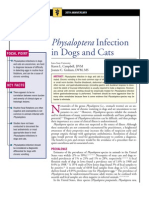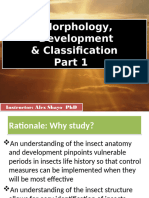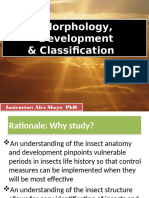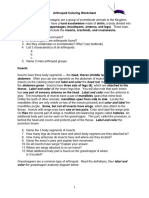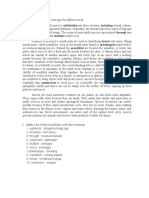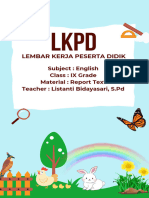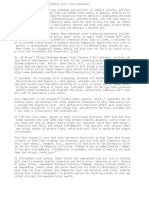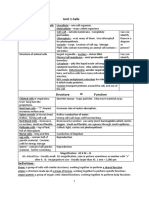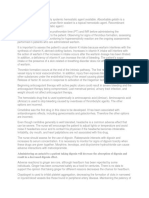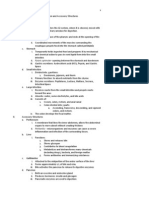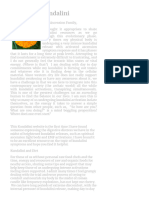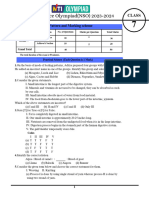0 ratings0% found this document useful (0 votes)
14 viewsGrade 8 English Language Week 12 Lesson 1
Grade 8 English Language Week 12 Lesson 1
Uploaded by
Jaiadraj Sumrah- The document is a lesson plan from the Ministry of Education for an 8th grade English class that focuses on reading and interpreting a passage about insects.
- The passage describes the distinguishing characteristics of insects such as their three pairs of legs, one pair of antennae, one or two pairs of wings, and that their bodies are divided into heads, thoraxes, and abdomens.
- It also notes that while young insects like caterpillars and maggots look different than their parents, they develop wings and harder exoskeletons as they mature into insects like beetles and wasps.
Copyright:
© All Rights Reserved
Available Formats
Download as PDF, TXT or read online from Scribd
Grade 8 English Language Week 12 Lesson 1
Grade 8 English Language Week 12 Lesson 1
Uploaded by
Jaiadraj Sumrah0 ratings0% found this document useful (0 votes)
14 views2 pages- The document is a lesson plan from the Ministry of Education for an 8th grade English class that focuses on reading and interpreting a passage about insects.
- The passage describes the distinguishing characteristics of insects such as their three pairs of legs, one pair of antennae, one or two pairs of wings, and that their bodies are divided into heads, thoraxes, and abdomens.
- It also notes that while young insects like caterpillars and maggots look different than their parents, they develop wings and harder exoskeletons as they mature into insects like beetles and wasps.
Copyright
© © All Rights Reserved
Available Formats
PDF, TXT or read online from Scribd
Share this document
Did you find this document useful?
Is this content inappropriate?
- The document is a lesson plan from the Ministry of Education for an 8th grade English class that focuses on reading and interpreting a passage about insects.
- The passage describes the distinguishing characteristics of insects such as their three pairs of legs, one pair of antennae, one or two pairs of wings, and that their bodies are divided into heads, thoraxes, and abdomens.
- It also notes that while young insects like caterpillars and maggots look different than their parents, they develop wings and harder exoskeletons as they mature into insects like beetles and wasps.
Copyright:
© All Rights Reserved
Available Formats
Download as PDF, TXT or read online from Scribd
Download as pdf or txt
0 ratings0% found this document useful (0 votes)
14 views2 pagesGrade 8 English Language Week 12 Lesson 1
Grade 8 English Language Week 12 Lesson 1
Uploaded by
Jaiadraj Sumrah- The document is a lesson plan from the Ministry of Education for an 8th grade English class that focuses on reading and interpreting a passage about insects.
- The passage describes the distinguishing characteristics of insects such as their three pairs of legs, one pair of antennae, one or two pairs of wings, and that their bodies are divided into heads, thoraxes, and abdomens.
- It also notes that while young insects like caterpillars and maggots look different than their parents, they develop wings and harder exoskeletons as they mature into insects like beetles and wasps.
Copyright:
© All Rights Reserved
Available Formats
Download as PDF, TXT or read online from Scribd
Download as pdf or txt
You are on page 1of 2
MINISTRYOF EDUCATION
SECONDARY ENGAGEMENT PROGRAMME
SEPTEMBER 2020
WEEK TWELVE: Lesson One
SUBJECT: English language
GRADE: Eight
TOPIC: Comprehension
SUB-TOPIC: Reading and interpreting passage
OBJECTIVES: For students to:
-read accurately and fluently
-interpreting the passage
-answer questions correctly
-understand and appreciate the writer’s craft
Comprehension Passage: Insects
Insects are variously formed, but as a rule the mature ones have three and only three pairs of
legs, one pair of feelers, one pair of large eyes, and one or two pairs of wings. The body is
divided into a head, thorax and abdomen. The head bears the eyes, feelers and mouth, the thorax
bears the legs and wings, and the abdomen is made up of a number of segments. The presence of
wings at once decides whether or not it is an insect, for, aside from bats and birds, insects alone
have true wings. These are the distinguishing characters of the full-grown insect, but, like birds,
they hatch from eggs and while young do not always look like their parents. When young they
may take on various shapes as caterpillars, borers, maggots, grubs, hoppers, and the like. Young
insects are often difficult to distinguish from true worms, centipedes, snails, and such forms, but
after one has collected and reared some of the young and watched them pass through the
different stages and emerge with wings they are much more easily recognized. Young insects as
a rule are soft like caterpillars and maggots, while the old ones usually have a hard body wall,
similar to the beetles and wasps. The wings are usually thin and transparent though in some cases
they are leathery or hard as in case of beetles or covered with scales as in the butterflies. The
three pairs of legs are jointed and used for running, climbing, jumping, swimming, digging or
grasping. The feelers or antennae are usually threadlike, clubbed, or resemble a feather and
extend forward or sidewise from the head. The large eyes are compound, being made up of many
great small units which, when magnified, resemble honey-comb. In some cases, two or three
small bead-like eyes may be present besides the two large eyes. The mouth parts of insects may
be formed for chewing, as in the grasshopper, or for sucking up liquids, as in the mosquito. The
mouth of an insect is built on an entirely different plan from our own. Chewing insects have an
upper and lower lip and between these there are two pairs of grinding jaws. These jaws are
157
hinged at the side of the face and when chewing they come together from either side so as to
meet in the middle of the mouth. They therefore work sidewise rather than up and down. The
mouth parts of the sucking insects are drawn out to form a sucking tube or proboscis as in case of
the butterfly or mosquito. The internal organs of insects are similar to those of other animals. The
digestive tube consists of esophagus, gizzard, or stomach, and intestines. The nervous system is
well developed as shown by the extreme sensitiveness of insects to touch. The brain is
comparatively small except in the bees and ants. The circulatory system consists simply of a long
tube heart, the blood vessels being absent. In this way the internal organs of the insect are simply
bathed in the blood. The system of respiration is most complicated. The air is taken in through
pores usually along the side of the body and is then carried through fine tracheal tubes to all parts
of the body. You cannot drown an insect by putting its head under water, since it does not
breathe through its mouth. The muscular system is similar to that of other animals which have
the skeleton on the outside.
Questions
1. What are the parts of an insect’s body?
2. What do insects have in common with birds?
3. What are young insects often mistaken for? Why?
4. How do young and mature insects differ?
5. Describe compound eyes.
6. Describe generally how insects’ mouths differ from our own.
7. How do the internal organs of insects compare to those of other animals?
8. Why can’t you drown an insect by putting its head under water?
158
You might also like
- 6th Great Minds Harriet TubmanDocument7 pages6th Great Minds Harriet TubmanJaiadraj Sumrah0% (1)
- C+F-Physaloptera Infection in Dogs and CatsDocument11 pagesC+F-Physaloptera Infection in Dogs and Catstaner_soysurenNo ratings yet
- Iri 3210 Practice Science 47447fa2016Document6 pagesIri 3210 Practice Science 47447fa2016api-340726722No ratings yet
- Chapter 4Document12 pagesChapter 4salazarwilfred675No ratings yet
- Lecture 2 General Body Form and Appandages of InsectsDocument5 pagesLecture 2 General Body Form and Appandages of InsectsRafiulNo ratings yet
- Bi 303 Applied Entomology Lecture 2 - Part 1Document20 pagesBi 303 Applied Entomology Lecture 2 - Part 1Tadele TilahunNo ratings yet
- Squid DissectionDocument3 pagesSquid Dissectionapi-296981910100% (1)
- Soal Penilaian Sumatif III Bahasa Inggris 10Document12 pagesSoal Penilaian Sumatif III Bahasa Inggris 10fzbm7wfz5wNo ratings yet
- Class 9 DIVERSITY IN LIVING ORGANISMSDocument6 pagesClass 9 DIVERSITY IN LIVING ORGANISMSrb547hjmrrNo ratings yet
- Materi Factual ReportDocument4 pagesMateri Factual Report07Angga Juneka PrasetyoX MM1No ratings yet
- External and Internal Anatomy of The FrogDocument3 pagesExternal and Internal Anatomy of The FrogLuther Abaya MolinaNo ratings yet
- THE GRASSHOPPERclassDocument37 pagesTHE GRASSHOPPERclassSafiqa Tasfia100% (1)
- Comprehension For Unseen Passages Class 12 I.com. A.B.M. CollegeDocument8 pagesComprehension For Unseen Passages Class 12 I.com. A.B.M. CollegeSophie100% (1)
- 1 Introductory EntomologyDocument27 pages1 Introductory EntomologyGaurav Gaur100% (1)
- Bi 303 Applied Entomology Lecture 2-December 2017Document56 pagesBi 303 Applied Entomology Lecture 2-December 2017Tadele TilahunNo ratings yet
- Frog Dissection LabDocument6 pagesFrog Dissection LabYummy GumNo ratings yet
- University of The Philippines Visayas TaclobanDocument1 pageUniversity of The Philippines Visayas TaclobanBambi AzulNo ratings yet
- Invertebrates 5º PrimariaDocument14 pagesInvertebrates 5º PrimariaIsa AlvNo ratings yet
- Full Download International Financial Management 13th ed. PDF DOCXDocument24 pagesFull Download International Financial Management 13th ed. PDF DOCXnevzetgenabe41100% (1)
- Lab. 2 - Immature InsectsDocument14 pagesLab. 2 - Immature InsectsJA BassNo ratings yet
- Sample Summary Writing Task - Grade 7Document7 pagesSample Summary Writing Task - Grade 7Rasyidy 'Eddy' AliasNo ratings yet
- 2013 - Report Test From Erlangga-Xi - Sem1Document55 pages2013 - Report Test From Erlangga-Xi - Sem1Novi Hervianti PutriNo ratings yet
- Module in English 10 Quarter IiiDocument22 pagesModule in English 10 Quarter IiiJaymar Magtibay100% (1)
- Grade 6 Activity For Nov. 20 22Document5 pagesGrade 6 Activity For Nov. 20 22Johnrobert GallanoNo ratings yet
- Green Tree BioDocument11 pagesGreen Tree Bioapi-396822110No ratings yet
- Reading Comprehension InsectDocument3 pagesReading Comprehension InsectDard TongNo ratings yet
- Butterfl Ies and Moths: Teacher's Guide Classroom ActivitiesDocument54 pagesButterfl Ies and Moths: Teacher's Guide Classroom ActivitiesIPI Accounting TeamNo ratings yet
- Ammocoete LarvaDocument8 pagesAmmocoete LarvaVarsha RaiNo ratings yet
- Notes in English of BiologyDocument3 pagesNotes in English of Biologylau fjNo ratings yet
- 06 Introduction To InsectsDocument18 pages06 Introduction To InsectsBoitumelo KortjassNo ratings yet
- Bio 104 2 Notes UploadsDocument20 pagesBio 104 2 Notes UploadsMbah chiomaNo ratings yet
- AFA Majorship (CROP PROTECTION)Document13 pagesAFA Majorship (CROP PROTECTION)Jonas CabacunganNo ratings yet
- Chapter 8 Animals EverywhereDocument2 pagesChapter 8 Animals Everywherearpita bhattacharyyaNo ratings yet
- Good BugsDocument25 pagesGood BugsOni MichaelNo ratings yet
- EntomologyDocument32 pagesEntomologyAnnie Aragona-SatoNo ratings yet
- Animal Life CyclesDocument5 pagesAnimal Life CyclesHarold LojzNo ratings yet
- GZOO111LB04 External Features of The Frog 1Document15 pagesGZOO111LB04 External Features of The Frog 1Michaella NagarNo ratings yet
- Science 4: Life Cycle of A FrogDocument27 pagesScience 4: Life Cycle of A FrogJennifer RagualNo ratings yet
- Arthropod ColoringDocument9 pagesArthropod ColoringaazaharvichNo ratings yet
- Lesson Plan 2q Sci - Docx 2024 25Document6 pagesLesson Plan 2q Sci - Docx 2024 25Grace NaduaNo ratings yet
- Read The Text Quickly and Sign The Difficult WordsDocument4 pagesRead The Text Quickly and Sign The Difficult WordsFirdaus Dwi Yulian 74934No ratings yet
- Types of LarvaDocument12 pagesTypes of LarvaFarrin Khanzlaluu Menunggunya100% (1)
- SCIENCE-6-Q2-W4_W5Document14 pagesSCIENCE-6-Q2-W4_W5margouxtalisicNo ratings yet
- 2 Information About InsectsDocument3 pages2 Information About InsectsSaaaaaNo ratings yet
- How to Raise a Healthy, Happy Well Adjusted ParrotFrom EverandHow to Raise a Healthy, Happy Well Adjusted ParrotRating: 4 out of 5 stars4/5 (1)
- InvertebratesDocument18 pagesInvertebratesainhoanicole2011No ratings yet
- Nursing Reflective EssaysDocument8 pagesNursing Reflective Essaysolylmqaeg100% (2)
- COT - 4a's LESSON PLAN IN SCIENCE 6 - SY 2021-2022Document6 pagesCOT - 4a's LESSON PLAN IN SCIENCE 6 - SY 2021-2022KJMD Kent Joshua M. Dumam-ag100% (10)
- LKPD ReportDocument3 pagesLKPD ReportListanti BidayasariNo ratings yet
- Topic: Insects Class: Senior Two, Term 1: General Characteristics IncludeDocument19 pagesTopic: Insects Class: Senior Two, Term 1: General Characteristics Includebukenya Moses100% (1)
- The Head The Antennae - Can Be Found On Top of TheDocument4 pagesThe Head The Antennae - Can Be Found On Top of TheAldrin PabloNo ratings yet
- Sa 2 English Comm Qp2Document243 pagesSa 2 English Comm Qp2Barani KrishnamoorthyNo ratings yet
- Integumentary System: Types of Bird FeathersDocument22 pagesIntegumentary System: Types of Bird FeathersIkenna UzuegbuNo ratings yet
- Ex 8 Toad's External AnatomyDocument1 pageEx 8 Toad's External AnatomyZaivie VillanobosNo ratings yet
- Entomology ReviewerDocument8 pagesEntomology ReviewerashimiyowNo ratings yet
- Animals With BackbonesDocument19 pagesAnimals With BackbonesDiyonata KortezNo ratings yet
- EntomologyDocument50 pagesEntomologyapi-19960301100% (1)
- General Zoology External Feautres of The FrogDocument10 pagesGeneral Zoology External Feautres of The FrogLevi Ledesma SadaranNo ratings yet
- English A Grade 10 Easter Term 2022 SchemeDocument12 pagesEnglish A Grade 10 Easter Term 2022 SchemeJaiadraj SumrahNo ratings yet
- 2022 Xmas Term WK 8 Comma, Personfication, Comprehension, Subject & VerbDocument26 pages2022 Xmas Term WK 8 Comma, Personfication, Comprehension, Subject & VerbJaiadraj SumrahNo ratings yet
- English A Grade 8 Easter Term 2022 SchemeDocument12 pagesEnglish A Grade 8 Easter Term 2022 SchemeJaiadraj SumrahNo ratings yet
- English A Grade 9 Easter Term 2022 SchemeDocument16 pagesEnglish A Grade 9 Easter Term 2022 SchemeJaiadraj SumrahNo ratings yet
- Bulbsoup: The Boy Who Loved Ice Cream - Literature NotesDocument4 pagesBulbsoup: The Boy Who Loved Ice Cream - Literature NotesJaiadraj SumrahNo ratings yet
- Grade 9 GDocument5 pagesGrade 9 GJaiadraj SumrahNo ratings yet
- English B Grade 8 Easter Term 2022-1Document8 pagesEnglish B Grade 8 Easter Term 2022-1Jaiadraj SumrahNo ratings yet
- Xmas Term WK 13 Adverb Phrase, Alliteration & Contex CluesDocument17 pagesXmas Term WK 13 Adverb Phrase, Alliteration & Contex CluesJaiadraj SumrahNo ratings yet
- J. Sumrah-1Document17 pagesJ. Sumrah-1Jaiadraj SumrahNo ratings yet
- English B Grade 8 Week 6Document13 pagesEnglish B Grade 8 Week 6Jaiadraj SumrahNo ratings yet
- Histology Slides For MBBS 1st Year (With Identification Points) - MedicoholicDocument79 pagesHistology Slides For MBBS 1st Year (With Identification Points) - MedicoholicPatel Om100% (1)
- Full download Small Animal Medical Differential Diagnosis: A Book of Lists Mark S. Thompson pdf docxDocument36 pagesFull download Small Animal Medical Differential Diagnosis: A Book of Lists Mark S. Thompson pdf docxedvalxhacka100% (4)
- General Biology 2 Quarter 4Document51 pagesGeneral Biology 2 Quarter 4MARLA RUBY PAZ YTING100% (1)
- Lecture 22 - The Digestive TractDocument32 pagesLecture 22 - The Digestive TractCarl Agape DavisNo ratings yet
- Digestive System of Frog PDFDocument20 pagesDigestive System of Frog PDFJake tars100% (1)
- Six Foods That Cleanse Your ColonDocument3 pagesSix Foods That Cleanse Your Colonasset68100% (1)
- Why Excess Stomach Acid Mimics HungerDocument13 pagesWhy Excess Stomach Acid Mimics Hungershane charltonNo ratings yet
- IGCSE Mastery SheetDocument48 pagesIGCSE Mastery SheetKexinNo ratings yet
- Kebo116 PDFDocument13 pagesKebo116 PDFbashraaNo ratings yet
- EarthwormDocument24 pagesEarthwormAlakesh Coldplay KalitaNo ratings yet
- Abram Study NotesDocument6 pagesAbram Study Notesteeman2No ratings yet
- Apache ScoreDocument36 pagesApache ScoreSugianto Parulian SimanjuntakNo ratings yet
- Taro Ice Cream: Elaine Jade PascuaDocument31 pagesTaro Ice Cream: Elaine Jade PascuaBlesvill BaroroNo ratings yet
- Digestion Quiz MraDocument4 pagesDigestion Quiz Mraapi-353447897No ratings yet
- GI Ch.44-47Document40 pagesGI Ch.44-47W11795800% (1)
- Biology of Kundalini - Energetic SynthesisDocument8 pagesBiology of Kundalini - Energetic SynthesisjenniferNo ratings yet
- Science4 DigestiveSystemDocument10 pagesScience4 DigestiveSystemKrisjelyn GumaroNo ratings yet
- Science 8 ReviewerDocument14 pagesScience 8 Reviewerlucel baganoNo ratings yet
- Super Teacher Worksheets Word SearchDocument3 pagesSuper Teacher Worksheets Word SearchMuhammad TayyabNo ratings yet
- Chapter 14. The Digestive SystemDocument27 pagesChapter 14. The Digestive SystemScianna Christel LastimosaNo ratings yet
- 1 s2.0 S0308814623002625 MainDocument12 pages1 s2.0 S0308814623002625 Main16Aviva Auralisa ArsantiNo ratings yet
- Case StudyDocument3 pagesCase StudyMhar IcelNo ratings yet
- Electronic Wireless Body Scanning SystemDocument19 pagesElectronic Wireless Body Scanning SystemAkshitha Manchukonda67% (3)
- Digestive SystemDocument9 pagesDigestive SystemMary Eilleen CabralNo ratings yet
- Alqahtani 2021Document21 pagesAlqahtani 2021Karla SanchezNo ratings yet
- Diarrhea NCPsDocument10 pagesDiarrhea NCPsJoia De LeonNo ratings yet
- Naturopathy TreatmentsDocument77 pagesNaturopathy TreatmentsDr Bharat Zinjurke100% (2)
- A New Classification For Surgical NEC During Exploratory Laparotomy: Introduction and Reproducibility AssessmentDocument9 pagesA New Classification For Surgical NEC During Exploratory Laparotomy: Introduction and Reproducibility AssessmentCirugia Pediatrica La RazaNo ratings yet
- NTI OLYMPIAD Science Class 7 2023Document6 pagesNTI OLYMPIAD Science Class 7 2023NTI Live LecturesNo ratings yet

